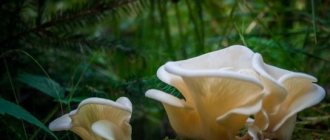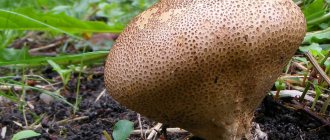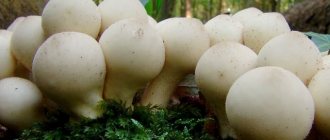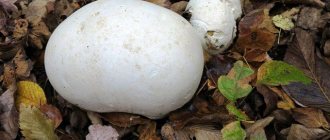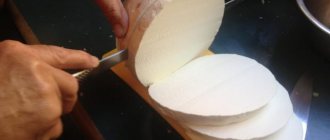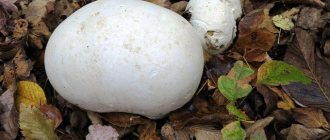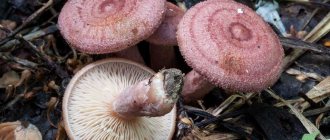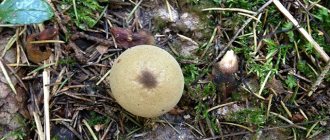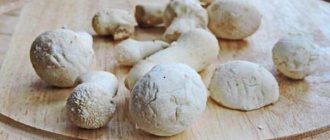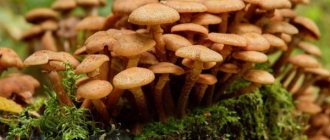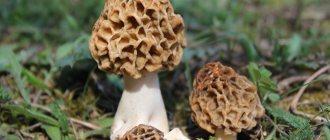Dust bombs
Is the puffball mushroom edible or not?
Puffballs or Lycoperdon are a genus of mushrooms from the Champignon family. They are widespread in the forests of Central Russia, especially at sunset in summer, and are very well known not only to fans of quiet hunting, but also to most residents of the country, especially in the second stage of ripening, when the tissues of the mushroom dry out, and it bursts with any rough touch, exploding into a dark cloud of spore powder. In the old glorious times, Soviet children had a favorite pastime at the end of summer, walking around and “slapping” their ripe raincoats. At the same time, everyone knew that young white raincoats should not be touched, and also that they could be used to make soup.
Among the people, the raincoat has many original names - bomb, smoky, duster, puffer, tobacco mushroom, smoker, devil's tavlinka, golovach, wolf's tobacco, grandfathers, or grandfather's tobacco, and many others - similar. Moreover, these mushrooms are directly called puffballs, hare potatoes or bee sponges at an early stage of development, when their fruiting body is still dense and white. It is believed that this mushroom got its name from its tendency to grow especially wildly after rains.
Interesting facts about the mushroom
Puffball puffball is a very nutritious mushroom; its beneficial properties are equal to boletus. In the 18th century, people with tuberculosis were treated with fluff soup.
This species got its name because it begins to grow quickly after heavy rain.
In Italy, wolf tobacco is considered one of the most delicious representatives of the mushroom kingdom.
Collected puffs are not stored for a long time, because they ripen quickly even after they are picked.
There are giant raincoats that weigh up to 10 kilograms. They resemble a large white ball and easily lift off the ground. They should not be kicked, as they release a huge cloud of spores, which can even cause respiratory arrest.
General external characteristics of the genus
Is the puffball mushroom edible or not?
The fruiting bodies of Raincoats have a closed structure and a rounded pear-shaped shape. The false stalk of the mushroom forms an inseparable structure with an upper spherical part, inside which spores ripen, and the upper surface of which is covered with characteristic spine-like outgrowths. When the spores mature, a small hole opens at the top of the mushroom, through which they are released into the external environment in the form of greenish or brown smoke. During this period, a light breeze is enough and the caps of these mushrooms will “smoke.”
Puffballs grow from early summer to late autumn, in various types of forests, depending on the species, on soil or decaying wood.
With rare exceptions, mushrooms of this genus are edible at an early stage, and are very tasty. They are used most often. for making soups, but are also good fried and pickled.
Undoubtedly, this mushroom is not for everyone - not everyone dares to pick it and eat it. Many people don't even realize that puffballs are edible. For some, their taste resembles chewed rubber, while for others, fried Raincoat is a true delicacy. – in this case, everything is individual.
Types of raincoats
There are several types of these mushrooms. Below are the most interesting of them, as well as their close relatives and inedible counterparts.
Contraindications
Despite the numerous medicinal properties that meadow raincoat has, we should not forget about contraindications. There are not too many prohibitions on eating mushrooms, but it is better to pay attention to them.
It is not recommended to use or treat raincoats during pregnancy (especially during the third trimester) and during lactation. For diseases of the digestive tract, it is also better to avoid this type of mushroom - they are very difficult to digest and can cause a serious aggravation. Children and elderly people can use raincoats, but in small portions.
Pear-shaped puffball has delicate flesh that actively accumulates harmful substances from the soil and air. That is why picking mushrooms near noisy highways or large industries is strictly prohibited - instead of benefiting the body, they can cause a number of side effects (intestinal upset, nausea, vomiting) and even poisoning.
Puffball Common or Spiny Lycoperdon Perlatum
Is the puffball mushroom edible or not?
The most famous and popular among edible puffballs is also known as the Pearl Puffball.
Appearance
The fruiting body is pear-shaped, the upper spherical part can reach a diameter of up to 5 cm, the lower cylindrical part is a false stalk, reaches a height of up to 6, and a diameter of up to 2.2 cm.
In young mushrooms, the fruiting body is white and dense, its upper part is covered with a network of small and large white spines, up to several millimeters in length. The spines are very fragile and easily fall off when touched.
The false stalk consists of dense sterile tissue, and the upper spherical part is filled with white, or slightly grayish, gleba. As the glebe ripens, the inside turns yellow and is divided into chambers, sent out by a spore-bearing layer, and when the ripening process is over, only a thick mass of brown-olive spore powder, separated by a few fibers, will remain inside. The outer surface of the fruiting body, during this time, becomes brownish-brown, and a hole is formed on top for the release of spores.
Where and when does it grow
The common puffball grows everywhere, from June to November, in meadows, and in coniferous and deciduous forests.
Common puffball mushroom how to cook
The mushroom is edible at an early stage, until its flesh turns yellow. There is information that some people eat mushrooms that have already begun to wither, but it is unlikely - this is correct - no toxins appear in the mushroom when it ages, but the taste disappears completely. Many connoisseurs consider this mushroom to be a genuine delicacy; according to rumors, it is especially adored in Italy. Most often, raincoats are fried or soup is made from them. There are few rules for eating Raincoat:
- Raincoats deteriorate very quickly after being cut, so they must be prepared immediately after collection.
- These mushrooms do not require pre-boiling, but they should not be eaten raw either.
- Before cooking, it is necessary to remove the top skin from the fruiting bodies - it is too hard. But if you want to marinate this mushroom, then you can leave the skin.
Storage and preparation
After collection, place it in a cold place, so the mushroom will not lose its beneficial properties for 1-2 days. To increase shelf life, it can be frozen by cutting it into small pieces. It can remain in this form for up to 6 months.
When dried or salted, the shelf life increases to 12 months. Young representatives of this genus of mushrooms can be cooked without prior boiling.
Before frying, boil the puffballs for about 10 minutes. And when consumed boiled, for complete readiness, boil for at least 15 minutes.
You can prepare raincoats safely and tasty using various recipes. The main thing is to collect only young mushrooms, having previously cut the fruiting body to ensure the white flesh and edibility of this specimen.
Pear-shaped puffball Lycoperdon Pyriforme
Is the puffball mushroom edible or not?
This species is remarkable because it grows on weakened tree trunks. Also known as the Bear Mushroom.
Appearance
The fruiting body is pear-shaped. The false stalk is often recessed in mosses, and the mushroom appears round. The upper part reaches a diameter of up to 7 and a height of up to 4 cm. In young specimens it is almost white and covered with light spines. As they ripen, the thorns fall off, the surface darkens and becomes covered with cracks, ripe specimens have a dirty brown color, and the skin is easily removed from them, like the shell from a boiled egg.
The pulp is initially soft and white, with a pleasant mushroom smell, but subsequently darkens and shrinks into a brown spore powder, which is ejected through a hole at the top.
Where and when does it grow
It grows from July to September in large groups on old mossy tree trunks, both deciduous and coniferous trees.
How to cook Pear-shaped Raincoat
It is edible when young, as long as the flesh remains white. Eating darkened specimens is fraught with food poisoning. It is recommended to remove the skin from the mushroom before use - it peels off very easily. There is a dispute about the need to pre-boil the mushroom and its effect on the taste - some argue that after boiling the taste of the fruiting bodies becomes rubbery. Many connoisseurs recommend frying this mushroom without boiling.
Growing at home
Some mushroom pickers are trying to grow tobacco mushrooms at home.
To do this, prepare an earthen trench dug in the shady part of a garden plot with sparse grass vegetation. Depth - 0.3 m, width - about 2 m.
Planting technology:
- Aspen, birch, poplar and willow leaves and branches are mixed into the pit, laid in layers of 2 cm, the total thickness of the layer is about 0.2 m;
- sprinkle with soil on top;
- sow the mycelium, distributing the mycelium evenly over the surface;
- watered using the drip method. When watering, a slight excess of moisture is considered acceptable;
- covered with branches.
Plantings are periodically moistened, avoiding drying out of the top layer of soil.
When caring for planted raincoats, water plays an important role: it is better to allow the mushrooms to become waterlogged than to lack moisture.
The mycelium begins to grow actively a month after sowing, as evidenced by thin, long white threads.
The overgrown mycelium is mulched with fallen leaves for the winter. Fruiting is observed a year after planting when optimal conditions are created. For regular growth of mushrooms, it is necessary to sow spores into the garden bed.
Raincoat Meadow Lycoperdon Depressum
Is the puffball mushroom edible or not?
This mushroom is also known as Puffball and Vascellum Meadow. It is famous for the fact that, unlike other representatives of its genus, it has a special partition separating the upper part and the false leg.
Appearance
The fruiting body initially has a spherical shape, then becomes pear-shaped, with a flattened crown, reaching a diameter of up to 6 and a width of up to 5 cm. Its upper surface is initially white-grayish and covered with characteristic spines. Subsequently, the thorns fall off, and the surface dries out, cracks and falls off, exposing the shiny inner surface, which also changes color from white to brownish-yellow. When the time comes to release the spores, a small hole forms at the top of the fruiting body.
The false stalk can be up to a centimeter long and has a wrinkled surface.
The flesh of the upper part is separated from the false leg by a shiny, grayish-brown septum. As it ripens, it changes color from white to orange to olive brown.
Where and when does it grow
It grows everywhere, from June to November, except in regions with a humid tropical climate, prefers dry meadows and clearings in forests of all types.
Culinary use of Lugovoy's puffball
The mushroom is edible at an early age, as long as the flesh remains light in color. It is not a particularly popular species in cooking, but it has similar nutritional properties to other edible puffballs.
The tasty family of puffballs also includes a mushroom from a neighboring genus.
Medicinal properties
Puffballs are superior in protein content to porcini mushrooms and champignons.
The fruiting bodies contain leucine, tyrosine, ergosterol, lipoids and various enzymes.
Galvacic acid, produced by puffballs and bigheads, inhibits the development of many bacteria and fungi, and also has an antitumor effect.
Many substances with antibiotic effects have been produced by chemical synthesis from galvacic acid.
Raincoats have long been used to treat kidney diseases and purulent wounds.
If you receive injury in the form of a cut in the forest, then the best hemostatic agent is a raincoat or bighead. For these purposes, only young specimens are taken, which are still dense inside, washed and cut or broken, then applied to the site of damage. As a result, bleeding stops and suppuration does not occur.
In the form of an infusion or decoction, it is used as an external hemostatic, antiseptic and anti-inflammatory agent.
The spores are used in homeopathy.
Used to treat kidney diseases.
Strengthens the reproductive glands.
Raincoat Giant Calvatia Gigantea
Is the puffball mushroom edible or not?
He is also Golovach Gigante and Langermania Gigante. This is an edible mushroom from the genus Calvacia, the Champignon family.
Appearance
The fruiting body has a spherical or ovoid, slightly flattened shape, and can reach a diameter of up to half a meter and a weight of up to 4 kg. At the very base of the mushroom, a thick mycelial cord is visible, connecting it to the mycelium. At a young age, the fruit body is white, then begins to turn browner as it matures. The outer shell is exoperidium, very thin and fragile. Soon after it begins to ripen, it breaks, flakes off and falls off in pieces.
Gleba - the flesh of the mushroom - is elastic and dense, at first also white, then turns yellow and green until it becomes olive-brown. Inside the gleba, a dark brown spore powder ripens, splashing out during the final ripening and destruction of the fruiting body. Spore powder can be shot up to several meters away.
Where and when does it grow
Golovach is found in the European territory of Russia, in Karelia, Siberia and the Far East, growing from June to September in fields, meadows, steppes, mixed and deciduous forests. Grows everywhere in the temperate zone. It has an interesting feature of bearing fruit in one place, but not every year, but with an interval of several years.
How to cook Giant Raincoat
Golovach is extremely tasty, but is suitable for food only at a young age, while its flesh remains white. The mushroom is delicious fried or boiled, and is used in many different dishes and snacks. The most classic recipe for preparing it is to cut it into slices, bread it and fry it in oil. For some, the taste of Golovach is more reminiscent of the taste of meat or fish.
Beneficial features
Golovach spore powder is an extremely useful medicine. In folk medicine, it is used as a natural anesthetic and a cure for laryngitis, smallpox and urticaria. Scientific research is also being conducted on the use of extracts from the spores of this fungus as an antitumor agent.
Raincoats have close inedible counterparts, belonging to a different genus and family, but similar in appearance. They are called False Raincoats.
Use in folk medicine. Recipes using raincoats
You can use hare potatoes in treatment even without heat treatment. Apply a fairly thin plate of the mushroom to a wound, abrasion or deep scratch to quickly stop bleeding, relieve pain and disinfect the affected tissue.
Crushed powder is an effective medicine for cancer. Place the pulp cut into thin slices on baking sheets, dry under the awnings, and grind in a blender. Take the prepared powder morning and evening, the recommended dosage for one dose is only 15 grams. Drink plenty of water. Store the product in a sealed container.
To strengthen the immune system, with high blood pressure and diseases of the cardiovascular system, it is recommended to regularly take the tincture:
- Mix spore powder (100 g) and vodka or homemade pervach (500 ml).
- Seal the bottle hermetically and place it in a warm and dark place.
- Over the course of a month, shake the bottle regularly to mix the contents.
- Strain, pour into a clean container, and store only in the refrigerator or cool cellar.
Drink 20 ml three times a day (preferably on an empty stomach). You can drink it with a small amount of water. Treatment is carried out in courses - a month of regular use of the drug and a week off.
For cancer, traditional medicine also recommends taking the following tincture:
- Combine spore powder (200 g) and vodka (1.5 l).
- Seal the bottle and bury it about 30-40 cm in the ground.
- After 3 weeks, dig out the container (do not shake!) and carefully strain.
Drink the product three times a day, only 15 ml. Take only on an empty stomach, with a minimum amount of water.
For problems with the kidneys or genitourinary system, traditional medicine recommends eating bread generously sprinkled with dry fungal spores. For treatment, it is better to use slightly stale white bread.
You can cook many delicious and healthy dishes from raincoats
Common puffball Scleroderma citrinum
Is the puffball mushroom edible or not?
An inedible mushroom of the genus False puffball, family Scleroderma. Also known as False Puffball Orange and Scleroderma Vulgaris. It is famous for its taste very similar to truffles, but can cause serious stomach upset if consumed in large doses. But it is relatively harmless in small quantities, which allows you to add it little by little to mushroom dishes to obtain a hint of truffle flavor.
Appearance
The fruiting body is tuberous, up to 6 cm. in diameter, with a dirty yellow or brownish surface, smooth or covered with small scales. The stalk is absent, and mycelial strands are visible at the base of the fruiting body.
The pulp of young fruiting bodies is white; with age, it gradually darkens, exfoliates, and turns into a brown powder that has the smell of raw potatoes. The shell of the old fruiting body becomes thinner and breaks easily, throwing the spore powder out.
Where and when does it grow
Grows from July to October, on loamy and clay soils, in coniferous and deciduous forests, but on soil or decaying wood. Loves to grow in mosses, along forest roads, in clearings and forest edges. It is also found in fields and meadows and is famous for its drought tolerance. In Russia, this mushroom can easily be found in the European part of the country, in the North Caucasus and the Far East.
The fruiting bodies of false puffballs are often home to the fungus Pseudoboletus Parasiticus .
Is the puffball mushroom edible or not?
Food use
Eating the pulp of the False Puffball will not kill anyone, but it will guarantee a serious eating disorder, and getting its spores into the nose and eyes can cause an allergic reaction. Used in cooking in very small doses due to its truffle flavor.
Spotted Puffball Scleroderma Areolatum
Is the puffball mushroom edible or not?
An inedible mushroom from the genus False puffball, family Scleroderma. Also known as False Puffball Panther and Scleroderma Leopardum.
Appearance
The fruit body is up to 5 cm in diameter, spherical or pear-shaped. It may have a short - up to 1.5 cm - false stalk, turning into the threads of the mycelium. The outer shell of young specimens is dense, although not thick, has a whitish or cream color that turns red when pressed; in mature specimens it is yellowish-brown and covered with peculiar brownish scales, which makes it look like leopard skin. In the oldest fruiting bodies, the scales fall off and the surface becomes covered with a reticulate pattern, eventually breaking through at the top to release the spores.
The pulp is initially light in color and fleshy in consistency, then darkens to olive-brown with light veins, eventually turning into dark brown spore powder.
Where and when does it grow
This species loves moist deciduous and coniferous forests, forest edges, open bright places - lawns and gardens. Widely distributed in the northern temperate zone. It bears fruit from August to October in groups, less often singly.
The nutritional value
The mushroom is officially considered inedible; if consumed in large quantities, it causes a serious eating disorder. There is no reliable data on its consumption in food in any form yet.
Similarities with raincoats
The spotted raincoat, due to its soft surface, is more similar to real raincoats than its other counterparts, but it is easy to distinguish it by the color of the inner flesh and its signature leopard-print coloring.
Puffballs are absolutely wonderful mushrooms. To the lucky and knowledgeable collector who finds them at the moment of edibility, they give an excellent delicacy, and to the one who was late and caught them in the “anther” stage - the opportunity to fool around to his heart’s content, kicking them, releasing a spore cloud, and again feeling like a playful child.
False doubles of hare potato mushroom
The puffball puffball can be confused with the false species. How to distinguish them?
The first is covered with distinct conical needles. If you remove the layer of light skin, a mesh pattern will become visible. These mushrooms have a pleasant smell. Porchowka very often grows in groups.
The false puffball is easy to distinguish from the edible species. False varieties have a dense, warty skin that is yellowish in color and often has small cracks on it. In old mushrooms, it dries out, breaks and the spores located below become visible.
The flesh of such specimens is yellowish even at a young age; on it you can see a marble pattern with white veins. The upper part of false mushrooms becomes dark, even black, over time. The smell is unpleasant. They grow in nests.
